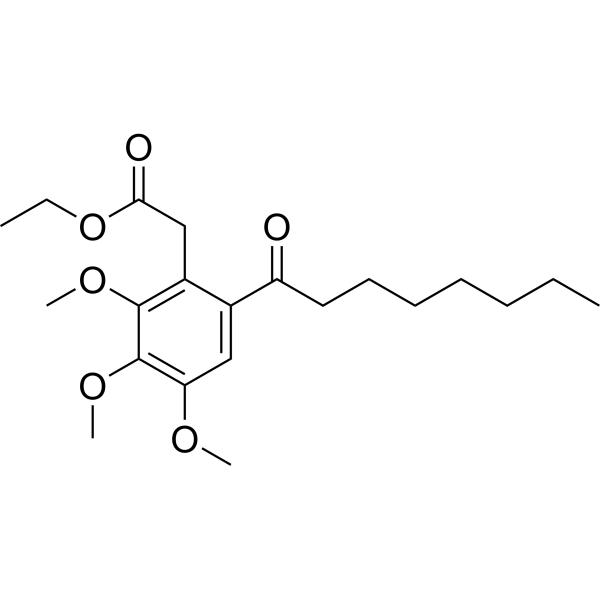产品
编 号:F098674
分子式:C21H32O6
分子量:380.48
分子式:C21H32O6
分子量:380.48
产品类型
规格
价格
是否有货
10mM*1mL in DMSO
询价
询价
2mg
询价
询价
5mg
询价
询价
10mg
询价
询价
50mg
询价
询价
100mg
询价
询价
结构图

CAS No: 1258275-73-8
产品详情
生物活性:
TMPA is a high-affinity Nur77 antagonist that binds to Nur77 leading to the release and shuttling of LKB1 in the cytoplasm to activate AMPKα. TMPA effectively lowers blood glucose and attenuates insulin resistance in type II db/db, high-fat diet and streptozotocin-induced diabetic mice. TMPA reduces RICD (restimulation-induced cell death) in human T cells, can also be used in studies of cancer and T-cell apoptosis dysregulation.
体内研究:
TMPA (50 mg/kg;腹腔注射;每天单次,持续 19 天) 能够降低 II 型糖尿病小鼠的血糖并改善葡萄糖耐量。Animal Model:Male C57BL/KsJ-Leprdb/Leprdb (db/db) mice (10-week-old; type II diabetic model).
Dosage:50 mg/kg
Administration:Intraperitoneal injection; single daily for 19 days.
Result:Significantly reduced blood glucose at day 7 and persisted during the remainder of the test.Increased the amount of phosphorylated AMPKα in the liver of mice.
体外研究:
TMPA (5、10、20、40、80 μM;6 小时或 10 μM;0.5、1、3、6、12、24、36、48 小时) 以剂量和时间依赖性的方式拮抗 Nur77-LKB1 相互作用在肝 LO2 细胞中的作用。 TMPA (10 μM;6 小时) 增强 Lo2 细胞生理条件下 LKB1-AMPKα 相互作用,但降低 LKB1-Nur77 相互作用。 TMPA 以特定构象直接与 LBD 结合。 TMPA (10,20 μM;6 h) 诱导 LKB1 核输出激活 Lo2 细胞中的 AMPKα。 TMPA (10、50、100 μM;4 小时) 损害人类 T 细胞 RICD (再刺激诱导的细胞死亡)。
TMPA is a high-affinity Nur77 antagonist that binds to Nur77 leading to the release and shuttling of LKB1 in the cytoplasm to activate AMPKα. TMPA effectively lowers blood glucose and attenuates insulin resistance in type II db/db, high-fat diet and streptozotocin-induced diabetic mice. TMPA reduces RICD (restimulation-induced cell death) in human T cells, can also be used in studies of cancer and T-cell apoptosis dysregulation.
体内研究:
TMPA (50 mg/kg;腹腔注射;每天单次,持续 19 天) 能够降低 II 型糖尿病小鼠的血糖并改善葡萄糖耐量。Animal Model:Male C57BL/KsJ-Leprdb/Leprdb (db/db) mice (10-week-old; type II diabetic model).
Dosage:50 mg/kg
Administration:Intraperitoneal injection; single daily for 19 days.
Result:Significantly reduced blood glucose at day 7 and persisted during the remainder of the test.Increased the amount of phosphorylated AMPKα in the liver of mice.
体外研究:
TMPA (5、10、20、40、80 μM;6 小时或 10 μM;0.5、1、3、6、12、24、36、48 小时) 以剂量和时间依赖性的方式拮抗 Nur77-LKB1 相互作用在肝 LO2 细胞中的作用。 TMPA (10 μM;6 小时) 增强 Lo2 细胞生理条件下 LKB1-AMPKα 相互作用,但降低 LKB1-Nur77 相互作用。 TMPA 以特定构象直接与 LBD 结合。 TMPA (10,20 μM;6 h) 诱导 LKB1 核输出激活 Lo2 细胞中的 AMPKα。 TMPA (10、50、100 μM;4 小时) 损害人类 T 细胞 RICD (再刺激诱导的细胞死亡)。
产品资料

